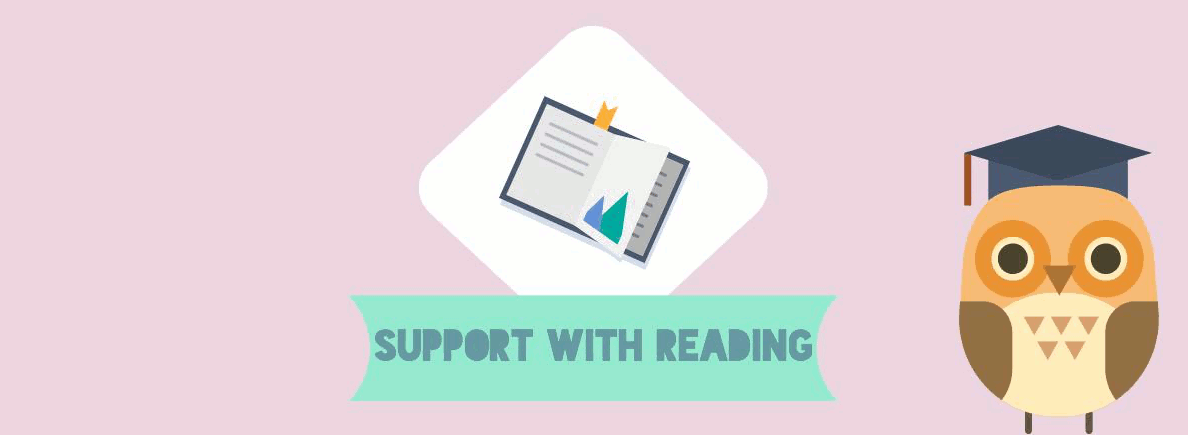
Supporting Your Child with Reading
How can I help my child prepare?
- Encourage them to read regularly. This should include a range of fiction as well as non-fiction texts, such as leaflets, newspapers and information books. Suggest that they try a different author or genre every couple of weeks to broaden their reading experience.
- Reading stamina is needed for the test, so encourage them to tackle longer passages and also check how long it takes them to read different texts carefully.
- Practice booklets with example questions can be helpful to prepare your child for giving written answers and to help them with timing issues.
Talk about what they have read. Here are some suggestions of ideas and questions to use…
Locating information
- Skim a text, such as a magazine article, to get a quick sense of what it is about. Talk about when this skill might be useful. Remind them that close reading is needed to understand a text fully.
- Ask them to ‘scan’ a text to find some key information. For example, glance through a synopsis of a film you are about to watch and find out the main characters’ names. Point out how we can easily find things like names and dates, due to the use of capital letters or numbers for dates.
Summarising
- Pick out five key facts from a non-fiction book they have read.
- Summarise the chapter they have read in three sentences.
- Sum up the main character in three words. What evidence do they have for this?
- Draw a timeline for the story.
Being a detective
- What did they learn about the main character’s feelings in the part of the book they have just read? What clues helped them work this out?
- Ask them to choose one key point in the story and write a thought bubble for one or more of the characters involved.
- Can they predict what might happen next? Have there been any ‘clues’? Remind them that their prediction should be based on evidence.
- Suggest that they reread the opening paragraph. Are there any clues about the time or place the story is set?
Looking at non-fiction texts
- Was there anything special about the away the text was laid out? Did it make the information more appealing or easy to read?
- Look at one of the illustrations. Are there any captions or labels? If not, could they add some?
Explore the words
- Are there any words they do not know? Could they work them out from the context? How could they check? Keep a list of interesting new words.
- Find a word that really stands out. Why is it a good word to use? Can they suggest any alternatives?
- Find an effective description which helps convey a picture or idea. Draw what they imagine based on the words used.
- Were there any technical or special words used by the author? Can they explain what they mean?
Changing viewpoints and ideas
- Did any characters change as the story progressed? What were they like to begin with? How had they changed by the end?
- Did their views about a character change as they read the book? Why?
- When reading a persuasive text or even a newspaper article: Did the author make them feel a particular way about the topic in the text? How? Did their view change as they read more about it?
- Does the text remind them of anything they have read before? How is it similar or different?
Value reading
- At the heart of reading comprehension lies talking about books. You can help your child by making sure your home is one where books are valued and where reading is seen as an enjoyable and worthwhile activity.
- Be a role model and let your child see you reading: for pleasure, for information and for purpose. Show that you read a range of different things for a variety of reasons.
- When encouraging your child to read, try to ensure they do it at a time when they are not too tired or hungry or busy playing. Help them to see it as a leisure activity not a chore.
Selecting books
- Provide opportunities for your child to browse books and select new ones to read. This need not be expensive: the local library, school book fairs and charity shops are all good places to browse. You’ll find some book recommendations in our Books category.
- Discuss the covers and blurb, talk about how the books are displayed, what appeals to and interests your child and whether they have read other books by the same author as ones on display.
Reading aloud vs being read to
- As children develop fluency, expect them to gradually want to read more on their own and less to you.
- Sharing the reading, by taking it in turns to read a page aloud, can be a good way to bridge this transition and supports your child to try books that may be a little challenging for them on their own.
- Use this opportunity to talk about unfamiliar words. Expanding your child’s vocabulary by talking about words and finding out what new words mean is a valuable way to support their reading comprehension skills.
- When your child is reading a book to themselves, it is still important to talk about the book and develop their understanding. Try encouraging them to sum up the page or chapter they have just read, in a sentence or two.
- Ask them to tell you about some of the characters: Can they tell you something interesting about one of the main characters? Which one would they like to be friends with? Do any of the characters face a problem? Do they have any advice for them?
Websites
This website has lots of ‘read the passage and then answer the questions’ style activities, which will be really useful practise. It is an American website, but replicates SATs style questions pretty well.
- http://mrnussbaum.com/readingpassageindex/
- http://web2.uvcs.uvic.ca/elc/studyzone/ – More questions about texts on this website. Choose the reading comprehension exercises.
- http://www.bbc.co.uk/bitesize/ks2/english/reading/ – The English area of the Bitesize website is split into different sections. The reading area has some useful resources, especially the deduction and finding information section.

